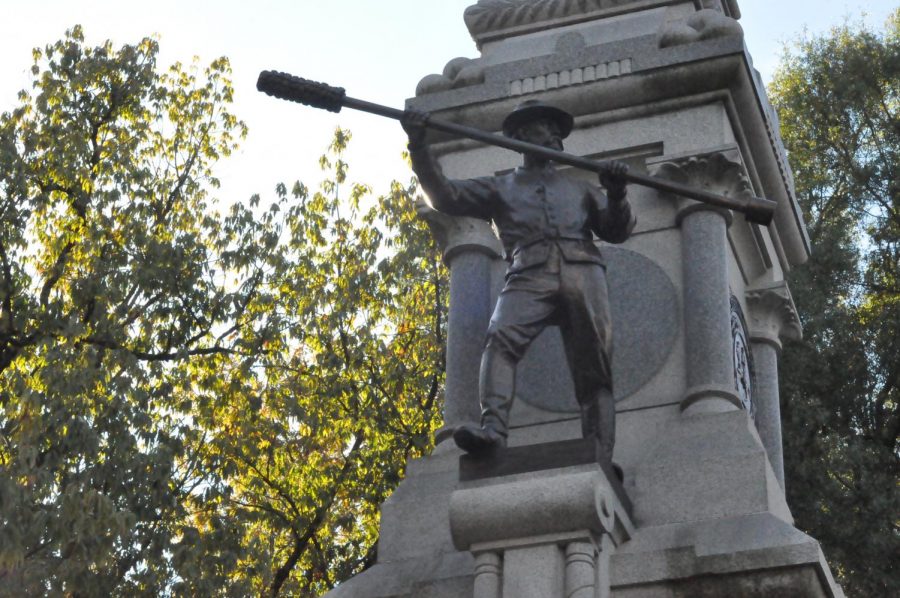Students express opinions for future of Confederate Monuments
This monument is on the capital grounds in Raleigh, N.C. This commemorates the state’s role in the Civil War.
February 12, 2018
Events in 2017 precipitated the removal of Confederate monuments in cities and towns around the country. After the events of the Unite the Right rally in Virginia in August, the topic was much in the spotlight.
But for many municipalities nationwide, like Raleigh, the debate was not settled, and as 2018 begins monuments remain in place, to the happiness of some and the disappointment of others.
In 2018, Wake Forest is a bustling and growing small city in its own right with a diverse population of people native to the town and transplants from all around, seeking work in the nearby cities of Raleigh and Durham or drawn here by the close proximity to the well-known tech-hub Research Triangle Park.
Through the years of the Civil War, Wake Forest was a rural farming town with a small college roughly 30 years old and a significant horse ride to the state capital. The town never erected its own Confederate monument.
Though Wake Forest hasn’t had to deal with this issue, many of its residents, including our students and staff, have voiced their thoughts on what should become of Confederate monuments.
In regards to such monuments being removed under the guidance of government officials, many of our students agree with decision.
“I think it’s a great idea because for many people they symbolize hate,” senior Asia Johnson said.
Sophomore Francis Graham holds similar sentiments.
“I think that it’s a positive choice because the confederate monuments represent hate, and I don’t think we need that in our country. People have the right of speech, but there’s a difference between hate and speech,” Graham said.
Others fear removing Confederate statues could have backfiring repercussions.
“I feel that the monuments represent a part of the past that needs to be remembered, good or bad. They are not there to offend anyone. If we took them all down, it would be like we were trying to erase parts of history, which is not how you prevent it from happening again,” junior Tyler Bland said.
To many this is a strong point to consider.
“I think it’s wrong because it’s a part of our history. I mean if you forget about history, then you’re bound to repeat it, and I feel like we should always have a reminder of what happened,” senior Owen Silber said.
Some, like freshman Charles Black, believe the problem is bigger than the monuments.
“Racism is a vile and evil thing as it has always been, but it’s one of those things where we can’t do much about it no matter how many confederate monuments we take down,” Black said.
There are also those who feel it is possible to remove some of the monuments while maintaining their history.
“We can’t erase our history, but we can move forward and create a better future,” sophomore Chloe Mair said.
Another aspect many consider is the original intent or purpose of Confederate monuments.
“A lot of the monuments were put in later in society as a means of showing racial dominance, and honestly, those should be removed,” AP Government and civics teacher Jeremiah Mattingly said. “Some monuments that show representation of why the war existed and occurred, I think, are more historical and are not based on race and are not based on intimidation. I think those historical ones should remain.”
Many of the Confederate monuments in the United States came about in the early 20th century. This is often attributed to the oppressive nature of the era.
“The removal of certain ones is necessary because of their purpose and why they were put there,” Mair said.
Some of the monuments have also been vandalized or destroyed. Mattingly believes going through the political process to remove them proves more than the unceremonious toppling of a statue.
“If you can influence the government and show them that your cause is just and correct, and then the government removes it, you’ve really won a battle,” Mattingly said.
Sophomore Elizabeth Buckley thinks the monuments can serve a better function elsewhere.
Buckley said, “I don’t agree with them being up, but I don’t think that they should be destroyed. I think that they should be put in a museum so we can look back on it, and then you can teach your children that these people were bad.”



